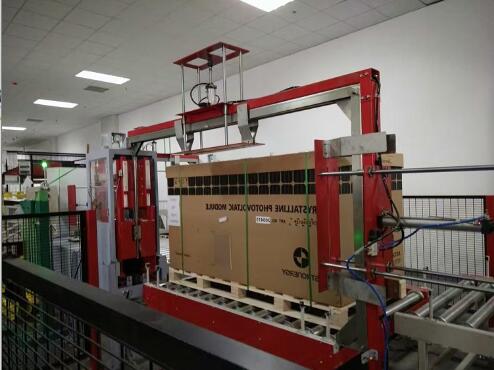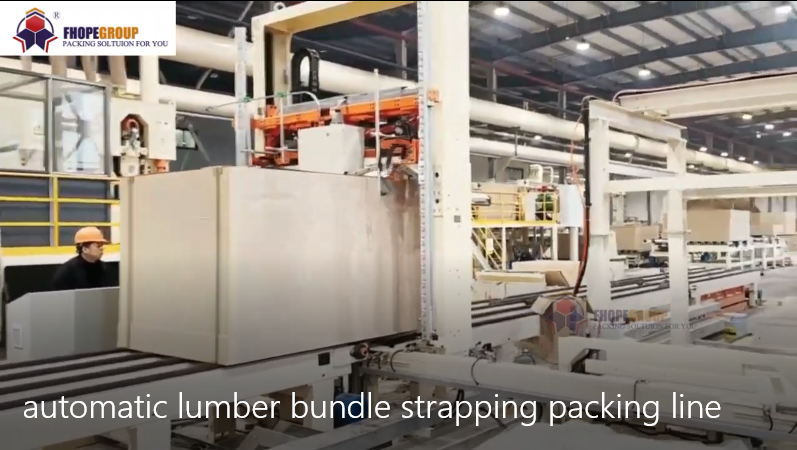Enhancing Logistics: A Comprehensive Guide to Automatic Pallet Strapping Machines
Ensuring the stability and security of palletized goods during transit and storage is paramount in modern logistics and warehousing. Damage during shipping can lead to significant costs and customer dissatisfaction. Automatic pallet strapping machines provide a robust solution, automating the process of securing loads for enhanced efficiency and protection. This guide delves into the operation, benefits, technical aspects, and considerations surrounding these essential pieces of packaging automation equipment.
1. What is an Automatic Pallet Strapping Machine?
An automatic pallet strapping machine is an industrial system designed to apply plastic (typically PP or PET) straps around palletized loads automatically. Its primary function is to unitize and stabilize products stacked on a pallet, preventing shifting, collapsing, or damage during handling, transportation, and storage. Unlike manual or semi-automatic methods, these machines integrate seamlessly into automated production or packaging lines, requiring minimal operator intervention.
2. The Strapping Process: How It Works
Understanding the operational sequence helps appreciate the machine's efficiency:
-
Pallet Infeed: The palletized load typically arrives via a conveyor system, positioning it accurately within the machine's strapping zone. Sensors detect the pallet's presence and dimensions.
-
Strap Feeding: The machine automatically feeds the strapping material (usually from a large coil) through the strap arch or directly around the pallet.
-
Strapping Application: Depending on the configuration, the machine applies straps vertically, horizontally, or in both directions (cross-strapping) to secure the load effectively. The video below demonstrates a typical vertical strapping process.
-
Tensioning: Once the strap encircles the load, the strapping head pulls it tight to a pre-set tension level. This is crucial for ensuring load stability without crushing the product. Modern machines offer precise electronic tension control.
-
Sealing: The overlapping ends of the strap are automatically sealed, typically using heat sealing (friction weld) technology, creating a strong, durable joint.
-
Cutting: The strap is cut cleanly near the seal, completing the cycle.
-
Pallet Outfeed: The secured pallet is then automatically conveyed out of the machine, making way for the next load.
The entire process is managed by a Programmable Logic Controller (PLC), which coordinates sensors, motors, and the strapping head, allowing for different strapping patterns and adjustments based on load profiles.

3. Key Features and Technical Specifications
When evaluating automatic pallet strapping machines, several technical aspects are important:
- Strapping Head Technology: The heart of the machine, responsible for tensioning, sealing, and cutting. Reliability and ease of maintenance are key.
- Control System: Typically PLC-controlled with an HMI (Human-Machine Interface) for easy operation, diagnostics, and parameter adjustments (e.g., tension, strap pattern, number of straps).
- Strap Types: Compatibility with different strap materials (Polypropylene - PP, Polyester - PET) and sizes (width, thickness).
- Tension Range: The machine's ability to apply a wide range of strap tensions to suit various load types, from fragile goods to heavy, stable products. Usually measured in Newtons (N) or kilograms (kg).
- Cycle Time: The time taken to complete one full strapping cycle, indicating the machine's throughput capacity (e.g., pallets per hour).
- Arch Size (for arch-type machines): Determines the maximum load dimensions (width and height) the machine can accommodate.
- Strapping Directions: Capability for vertical strapping, horizontal strapping, or both. Some advanced models offer programmable cross-strapping patterns.
- Conveyor Integration: Designed for seamless integration with powered roller or chain conveyor systems.
- Flexibility: Ability to handle pallets with or without bottom support blocks (underblocks), adapting to varying load configurations.
Typical Parameter Ranges:
- Cycle Speed: 15-60 seconds per cycle (depending on straps per pallet and configuration)
- Tension: 100 N - 4500 N (highly variable based on machine duty)
- Applicable Strap: PP or PET, 9mm - 19mm width
- Power Supply: Typically 380V/50Hz/3Phase (or customized)
4. Core Benefits of Automation in Pallet Strapping
Implementing an automatic pallet strapping machine brings significant advantages:
- Enhanced Load Security: Consistent and optimal strap tension significantly improves load stability, drastically reducing the risk of product damage during transit. Strapping in multiple directions offers superior containment.
- Increased Throughput: Automation dramatically speeds up the packaging process compared to manual or semi-automatic methods, boosting overall line efficiency.
- Improved Consistency: Machines apply straps with the same pattern and tension every time, ensuring uniform load security and quality control.
- Labor Cost Reduction: Frees up personnel previously engaged in manual strapping for higher-value tasks, reducing direct labor costs.
- Operator Safety: Reduces manual handling and the risks associated with tensioning tools, creating a safer working environment.
- Material Optimization: Precise tension control prevents over-tensioning (which can damage products) and under-tensioning (which compromises stability), potentially optimizing strap consumption.
5. Choosing the Right Machine: Key Considerations
Selecting the appropriate automatic pallet strapper requires evaluating several factors:
- Load Characteristics: Consider the size range (L x W x H), weight, stability, and fragility of your typical palletized loads.
- Throughput Needs: Match the machine's cycle speed to your production line's output requirements (pallets per hour).
- Strapping Requirements: Determine if vertical, horizontal, or cross-strapping is needed for optimal load containment. Consider the number of straps required per pallet.
- Strap Preference: Decide between PP (general purpose, economical) and PET (higher strength, better tension retention for heavy loads) strapping. Ensure the machine is compatible.
- Operating Environment: Consider factors like temperature, dust, and moisture levels, which might influence machine design or require specific protection ratings.
- Integration: How easily will the machine integrate with your existing conveyor systems and control architecture?
- Budget vs. TCO: Look beyond the initial purchase price to consider the Total Cost of Ownership, including maintenance, spare parts availability, energy consumption, and potential downtime.
- Vendor Support: Evaluate the manufacturer's reputation, warranty, technical support availability, and operator training options.
6. Maintenance and Operational Best Practices
To ensure longevity and optimal performance:
- Regular Cleaning: Keep the strapping head and surrounding areas free from dust and debris, especially strap fragments.
- Preventive Maintenance: Follow the manufacturer's recommended schedule for lubrication, inspection of wear parts (cutters, tension wheels, heat elements), and strap path checks.
- Strap Quality: Use high-quality strapping material recommended by the machine manufacturer. Poor quality strap can cause feeding issues and inconsistent seals.
- Operator Training: Ensure operators are properly trained on machine operation, safety procedures, basic troubleshooting (e.g., clearing strap jams), and routine checks.
- Parameter Settings: Regularly verify that tension and strapping pattern settings are appropriate for the loads being processed.

Conclusion
Automatic pallet strapping machines are indispensable assets in modern packaging and logistics operations. By automating the critical task of load stabilization, they deliver significant improvements in efficiency, consistency, safety, and product protection. Understanding their functionality, key specifications, and the factors involved in selecting the right system allows businesses to leverage this technology effectively, strengthening their supply chain and reducing costly transit damage. Integrating such automation is a key step towards optimizing warehouse and distribution workflows.
For more information on integrated packaging solutions, explore options in Automatic Packing Lines.

